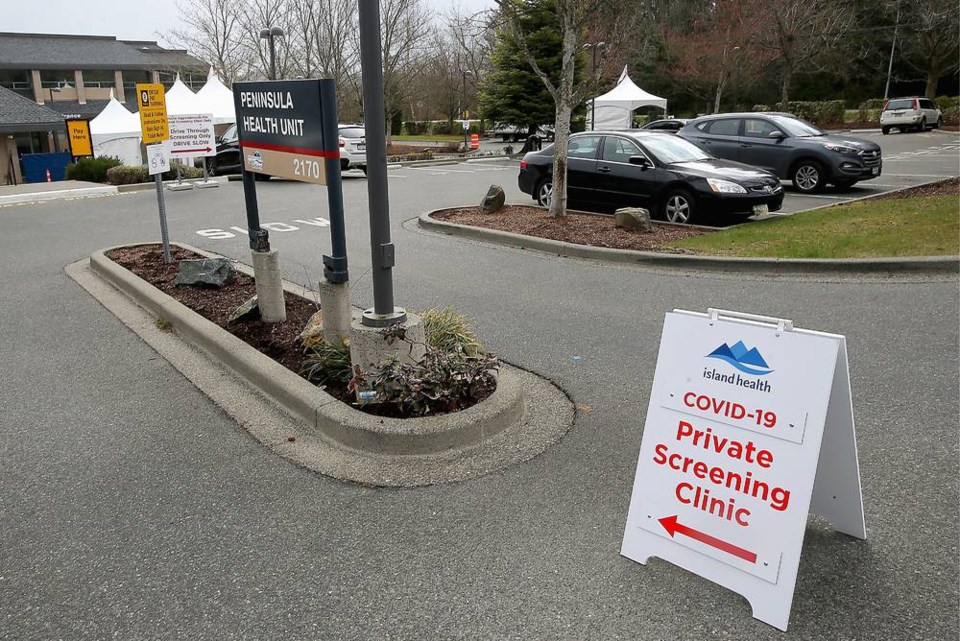With 12 new COVID-19 cases on Vancouver Island announced Thursday and 20 the day before, modelling experts say the Island’s cases are doubling every eight to 12 days, the highest doubling rate among all B.C. health regions.
“Twenty cases per day on the Island seems low now,” said Daniel Coombs, an epidemiologist the University of British Columbia who uses mathematical modelling to project how the virus will grow. “But given the rate of exponential growth, it can increase quite rapidly after a while.”
That means in less than two weeks, those 20 cases could grow to 40 a day and in a month, it could be up to 80 cases a day. Coombs stressed that’s not a prediction but a projection of where things could be headed if people don’t limit their travel and exposure.
On Thursday, the provincial health officer asked British Columbians to stop all non-essential travel.
Caroline Colijn, a Simon Fraser University epidemiologist, said her estimates show a doubling rate closer to every eight days, “which is the fastest of the health authorities.” She stressed that while Vancouver Island’s case numbers remain low, “it’s really time for the Island to be on the lookout.”
As of Wednesday, there were 118 active cases on the Island — 28 in the south, 76 in the central Island and 14 in the north. There have been a total of 429 COVID cases on Vancouver Island since the pandemic started.
Coombs pointed out how quickly the virus has spread on the Lower Mainland, where there were single-digit daily COVID-19 increases in June, which rose to daily cases in the 80s in August and now daily cases topping 700.
Vancouver Island, which saw no new cases of the virus for a two-week period in May and only a handful of new cases per day over the summer, is now doubling at a rate faster than the Lower Mainland, Coombs said.
On the Lower Mainland, where 487 new cases were announced Thursday, cases are doubling every 14 days.
“Even though [the Lower Mainland] … is in a much worse place than Vancouver Island, things are getting worse more slowly,” Coombs said.
Dr. David Forrest, an infectious disease and critical-care physician who works out of Nanaimo Regional General Hospital, cautioned that it’s difficult to project what will happen with case numbers because of variations that depend on the intensity of testing and contact tracing.
“It’s hard because the statisticians are basing the numbers on there being some sort of accuracy and that there’s a steady state in terms of the testing and I don’t think that’s the case,” Forrest said. For example, if six people in a household test positive for the virus, that could lead to a large jump in the numbers regionally, but it doesn’t mean there’s community spread.
“There’s a lot of uncertainty as to where this is going, but genuine alarm that our numbers, without question, are going up,” he said.
Both Coombs and Colijn stressed that projections could fluctuate based on new clusters and outbreaks that don’t always follow statistical trends.
Colijn said it appears the bulk of cases on Vancouver Island have come from travel to and from the Lower Mainland.
She said stricter rules preventing tens of thousands of people a month from travelling to and from Vancouver Island might be the only way to reduce the spread of the virus.
“When you literally have boatloads of people travelling, you risk having someone on that boat who doesn’t know they’re sick and then transmitting it to other people on Vancouver Island,” Colijn said.
Vancouver Island chief medical health officer Dr. Richard Stanwick said 86 of 133 COVID-19 cases on the Island between Sept. 1 and Nov. 10 came from travel off the Island. Twenty people came from other parts of B.C. to the Island, brought the virus with them and passed it on to 11 Vancouver Island residents, who then passed it on to four more Islanders, Stanwick said.
Stanwick has floated the idea of an Island bubble where non-essential travellers coming here would be ordered to quarantine for 14 days, much like the Maritime provinces’ “Atlantic bubble.” However, on Thursday provincial health officer Dr. Bonnie Henry ruled out such a quarantine, stressing that people should instead avoid non-essential travel across the province and across regions.
Coombs said if stopping the coronavirus from spreading entirely was our number-one goal, “we would just tell everybody to stay home like they did in Australia or New Zealand.” However, he said B.C. seems to be charting a middle course that allows businesses and workplaces to remain open.
“I think at the moment, given the vast majority of transmission in the province is in the Lower Mainland, it’s pretty reasonable to ask people in strong terms to reduce non-essential travel,” Coombs said.



